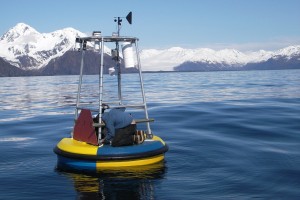UAF installs ocean acidification buoy in Alaska waters
May 11, 2011

907-322-8730
5/11/11
A new set of buoys in Alaska waters will help scientists understand how climate change may be affecting the pH level of northern seas. Researchers placed the first buoy last month.
“This is the first dedicated ocean acidification mooring to be deployed in a high-latitude coastal sea,” said Jeremy Mathis, principal investigator for the project and an assistant professor of chemical oceanography at the University of Alaska Fairbanks. “Other moorings have been deployed with ocean acidification sensors, but this is the first complete package in Alaska.”
The first buoy is at the mouth of Resurrection Bay, near Seward. It was assembled at UAF’s Seward Marine Center with the help of Chris Sabine, a senior scientist and co-principal investigator at NOAA’s Pacific Marine Environmental Laboratory.
A second buoy will be deployed in the Bering Sea this month, and a third will be placed in the Chukchi Sea in October. The data collected by the buoys will be sent to scientists in real time via satellite.
The top of each buoy floats at the ocean’s surface and the bottom is anchored to the seafloor. Each buoy contains two sets of instruments. The first set, at the water’s surface, measures the water’s acidity or alkalinity, or pH, as well as water temperature, carbon dioxide levels and other data. The second set of instruments, near the bottom, collects data on pH, carbon dioxide, temperature, salinity and other information.
Ocean acidification is the term used to describe increasing acidity in the world’s oceans. As carbon dioxide levels rise in the atmosphere, the ocean absorbs it like a sponge, making seawater more acidic. Scientists estimate that the ocean is 25 percent more acidic today than it was 300 years ago.
According to Mathis, the coastal seas around Alaska are more susceptible to ocean acidification because of unique circulation patterns and colder temperatures. These factors increase the transport of carbon dioxide from the atmosphere into surface waters.
Mathis adds that the buoy will also help scientists determine how seawater pH changes throughout the seasons.
“We know that there is quite a bit of variability in the water throughout the year and right now all we have are snapshots from our cruises. Sometimes we find water that is acidic enough to potentially be harmful to certain organisms, but we don’t know how long it persists or how extensive it is,” he said.
With support from the North Pacific Research Board and NOAA, Mathis and Sabine have built systems that can begin to close the information gap on ocean acidification in Alaska’s commercially important coastal regions.
“These buoys are really going to provide some new insights and understanding for ocean acidification in the Pacific-Arctic region,” said Mathis. “We know that these areas are going to experience a dramatic change in pH over the coming decades and, given the importance of the fisheries, we have to stay out in front of any potential disruptions that could be caused by rising carbon dioxide levels.”
About SFOS
The UAF School of Fisheries and Ocean Sciences conducts world-class marine and fisheries research, education and outreach across Alaska, the Arctic and Antarctic. 60 faculty scientists and 150 students are engaged in building knowledge about Alaska and the world's coastal and marine ecosystems. SFOS is headquartered at the University of Alaska Fairbanks, and serves the state from facilities located in Seward, Juneau, Anchorage and Kodiak.
ADDITIONAL CONTACTS: Jeremy Mathis, assistant professor of chemical oceanography, 907-474-5926 or via e-mail at jmathis@sfos.uaf.edu
ON THE WEB: www.sfos.uaf.edu
NOTE TO EDITORS: A photo of the buoy is available online at www.uafnews.com.
CS/5-11-11/229-11


